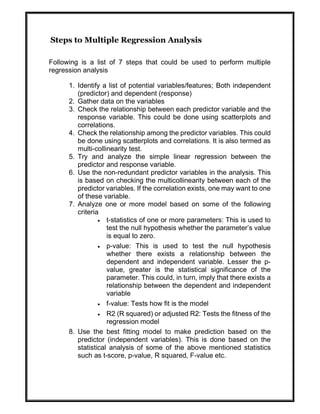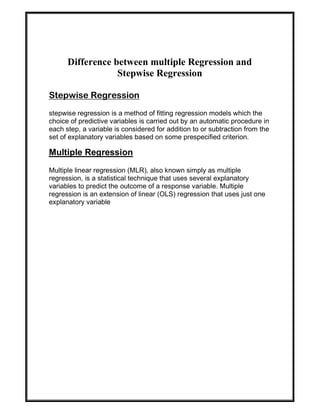Stepwise, Multiple and Cluster regression.pdf
- 1. JC BOSE UNIVERSITY OF SCIENCE AND TECHNOLOGY, YMCA, FARIDABAD (MASTERS OF BUSINESS ADMINISTRATION) 2022-2024 RESEARCH LAB PROJECT FILE SUBMITTED BY: GOLDY SINGH ROLL NUMBER: 22001701037 Course: MBA (2022-2024) UNDER THE SUPERVISION OF Miss Komal (Scholar) Department of Management Studies
- 2. CERTIFICATE This is to certify that the project entitled, “(RESEARCH LAB)” has been carried out by GOLDY SINGH of MBA bearing Roll No. 22001701037 during the academic year 2022-2024. I have immense pleasure in forwarding the project to the Department of management, JC Bose University of Science and Technology. It is further certified that the research work included in the project is carried out by the candidate during her practical. Miss Komal (SCHOLAR) Department of MANAGEMENT JC Bose university of science and technology, Faridabad, Haryana
- 3. ACKNOWLEDGEMENT The success and the final outcome of this Research Lab Practical File require a lot of guidance and assistance from many people and we extremely fortunate to have got this all along the completionof our assistance work. Whether we have done only to such guidance and assistance and we could not forget to thank them. I respect and thanks our faculty guide Ms. KOMAL for giving us an opportunity to do this project work and providing us all support and guidance which made me complete the projecton time, we are extremely grateful to her for providing such a nice support and guidance.
- 4. INDEX 1 STEP WISE REGRESSION Introduction Assumption Steps in process Interpretation and results 2 Difference between multiple regression and stepwise regression. 3 CLUSTER ANALYSIS Introduction Assumption Steps in process Interpretation and results
- 5. What Is Stepwise Regression? Stepwise regression is the step-by-step iterative construction of a regression model that involves the selection of independent variables to be used in a final model. It involves adding or removing potential explanatory variables in succession and testing for statistical significance after each iteration. The availability of statistical software packages makes stepwise regression possible, even in models with hundreds of variables. Assumptions Let’s look at the important assumptions in regression analysis: 1. There should be a linear and additive relationship between dependent (response) variable and independent (predictor) variable(s). A linear relationship suggests that a change in response Y due to one unit change in X¹ is constant, regardless of the value of X¹. An additive relationship suggests that the effect of X¹ on Y is independent of other variables. 2. There should be no correlation between the residual (error) terms. Absence of this phenomenon is known as Autocorrelation. 3. The independent variables should not be correlated. Absence of this phenomenon is known as multicollinearity. 4. The error terms must have constant variance. This phenomenon is known as homoskedasticity. The presence of non-constant variance is referred to heteroskedasticity. 5. The error terms must be normally distributed.
- 6. Steps to Multiple Regression Analysis Following is a list of 7 steps that could be used to perform multiple regression analysis 1. Identify a list of potential variables/features; Both independent (predictor) and dependent (response) 2. Gather data on the variables 3. Check the relationship between each predictor variable and the response variable. This could be done using scatterplots and correlations. 4. Check the relationship among the predictor variables. This could be done using scatterplots and correlations. It is also termed as multi-collinearity test. 5. Try and analyze the simple linear regression between the predictor and response variable. 6. Use the non-redundant predictor variables in the analysis. This is based on checking the multicollinearity between each of the predictor variables. If the correlation exists, one may want to one of these variable. 7. Analyze one or more model based on some of the following criteria t-statistics of one or more parameters: This is used to test the null hypothesis whether the parameter’s value is equal to zero. p-value: This is used to test the null hypothesis whether there exists a relationship between the dependent and independent variable. Lesser the p- value, greater is the statistical significance of the parameter. This could, in turn, imply that there exists a relationship between the dependent and independent variable f-value: Tests how fit is the model R2 (R squared) or adjusted R2: Tests the fitness of the regression model 8. Use the best fitting model to make prediction based on the predictor (independent variables). This is done based on the statistical analysis of some of the above mentioned statistics such as t-score, p-value, R squared, F-value etc.
- 7. Steps involved in multiple regression 1.Click Analyze > Regression > Linear... on the main menu, as shown below 2.You will be presented with the Linear Regression dialogue box below:
- 8. 3. Transfer the dependent variable, VO2max , into the Dependent: box and the independent variables, age , weight , heart_rate and gender into the Independent(s): box, using the buttons, as shown below (all other boxes can be ignored): 4. Click on the button. You will be presented with the Linear Regression: Statistics dialogue box, as shown below:
- 9. 5. In addition to the options that are selected by default, select Confidence intervals in the –Regression Coefficients– area leaving the Level(%): option at "95". You will end up with the following screen: 6.Click on the button. You will be returned to the Linear Regression dialogue box. 7.Click on the button. This will generate the output.
- 12. Difference between multiple Regression and Stepwise Regression Stepwise Regression stepwise regression is a method of fitting regression models which the choice of predictive variables is carried out by an automatic procedure in each step, a variable is considered for addition to or subtraction from the set of explanatory variables based on some prespecified criterion. Multiple Regression Multiple linear regression (MLR), also known simply as multiple regression, is a statistical technique that uses several explanatory variables to predict the outcome of a response variable. Multiple regression is an extension of linear (OLS) regression that uses just one explanatory variable
- 13. CLUSTER ANALYSIS Cluster analysis or clustering is the task of grouping a set of objects in such a way that objects in the same group (called a cluster) are more similar (in some sense) to each other than to those in other groups (clusters). It is a main task of exploratory data analysis and a common technique for statistical data analysis, used in many fields, including pattern recognition, image analysis information retrieval, bioinformatics, data compression, computer graphics and machine learning.














